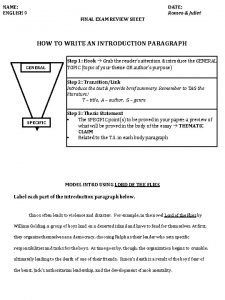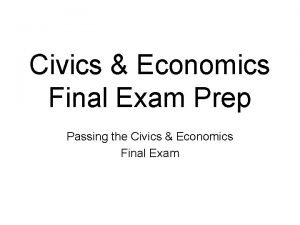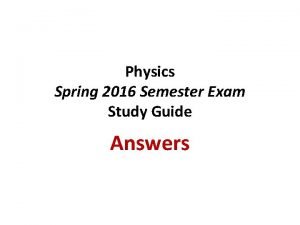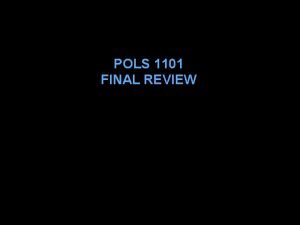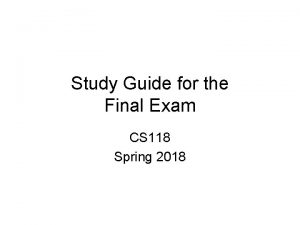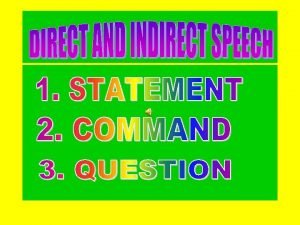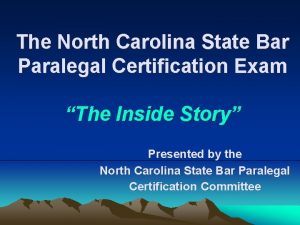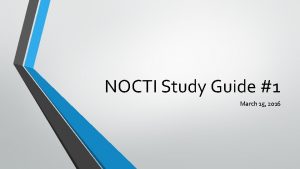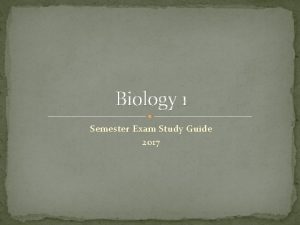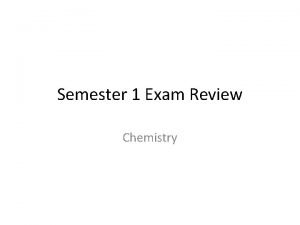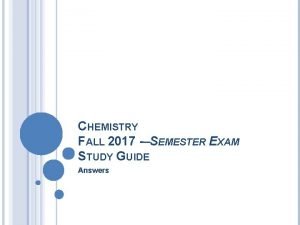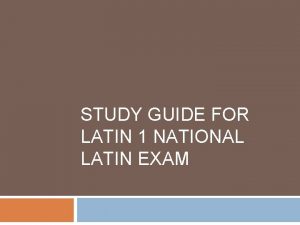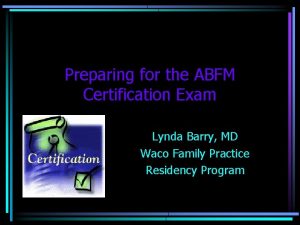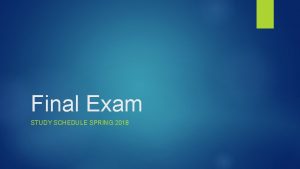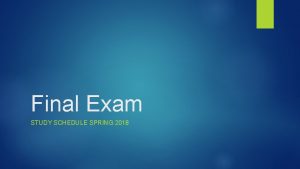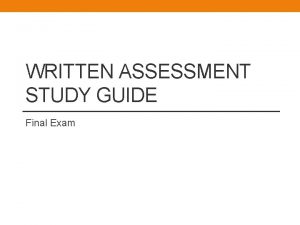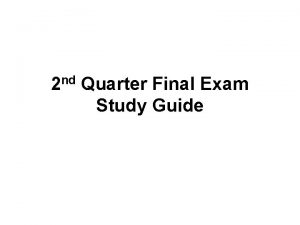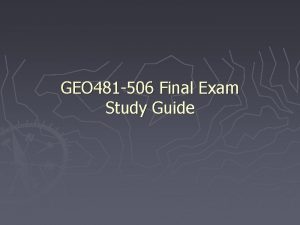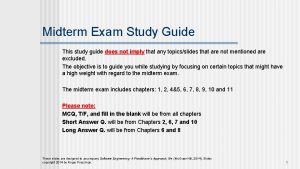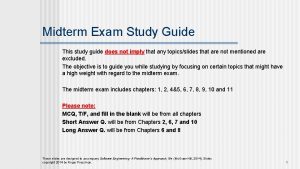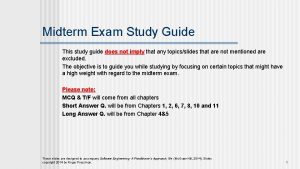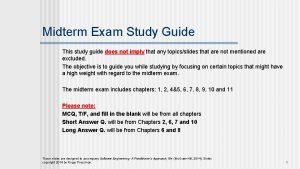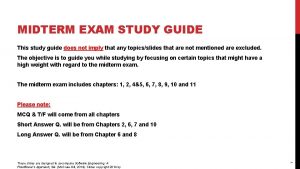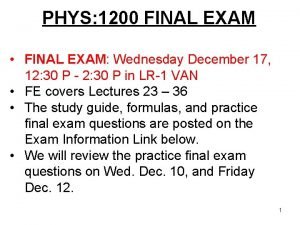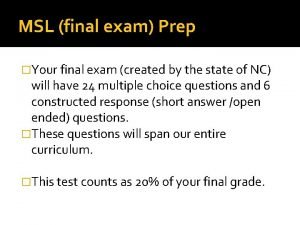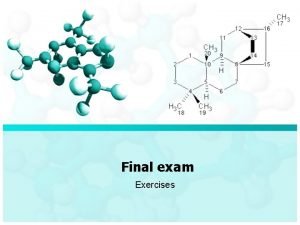Study Guide for the Final Exam CS 118




















- Slides: 20

Study Guide for the Final Exam CS 118 Spring 2018

Rules for Final Exam • Closed book, closed notes • No calculators/laptops/desktops & Internet access would be allowed • You can bring in 2 pages of “cheat sheets” to the final exam – Page size: 8 x 11; can be double-sided – Whatever font size you’d like

Major Breakdowns • Materials covered after the midterm: 80% – Chapters 4 -8 – 7 th edition (Chapter 4, Chapter 5. 1 -5. 4, Chapter 5. 6, Chapter 6. 1, 6. 2. 3, 6. 3. 1~5. 3. 3, 6. 4, 6. 5, 6. 6, 6. 7, Chapter 7. 1~7. 2, 7. 3. 1~7. 3. 4, 7. 5, 7. 6, 7. 7, Chapter 8. 1, 8. 2, 8. 4, 8. 6, 8. 7, 8. 9) – Lecture slides, posted RFC on course webpage • Materials covered in the midterm: 20% – Reliable data transfer – TCP retransmission timeout, TCP congestion control, TCP connection management – (possibly) also a couple of short Q&A

Materials to Be Covered • Lecture notes as the focus – (also check for the referred textbook chapters in the previous slide) – The followup slides can serve as study guide when you review such materials • 2 Programming Projects • Homeworks • Posted RFC

Reliable Data Transfer • Can you enumerate all the basic mechanisms needed to ensure reliable data transfer? • How to handle the following scenarios (if any exists) using Stop-and-Wait, Go-back-N, or selective repeat? – – – Packet loss Packet corruption Corrupted ACK Lost ACK duplicate packets Out-of-order packet delivery

TCP Protocol • TCP round-trip estimation and timeout – Is the Sample. RTT computed for a segment that has been retransmitted? Why? • What is the negative effect if the timeout value is set too small, or too big? • Why does sample. RTT fluctuate? • how does TCP readjust its timer? (see lecture slides) – When receiving a new ACK – When receiving a duplicate ACK? – When the current timer expires for N times?

TCP Connection Management • What is 3 -way handshake? – How are the initial seq, ACK #, etc. decided? • Are the TCP connection setup and teardown identical? – Why are they different? – Why do you need so many states in the FSM model for TCP connection?

TCP Congestion Control (slides & RFC) • how many components are there in TCP congestion control? • how does each work? slow start, congestion avoidance, fast rexmit/fast recovery. • how are cwnd and ssthresh adjusted in each phase?

Chapters 4&5 Network Layer • What is the Internet service model? • Comparing VC and datagram networks • How does a router decide which next hop to forward when a packet arrives? • What is the rationale for each field in the IP packet header? • IP fragmentation & reassembly • What is subset? What is CIDR? • How does NAT work? What about DHCP? • What fields exist in IPv 4 but not in IPv 6? What exist in IPv 6 but not in IPv 4? What exist in both?

Chapters 4&5 • How does the tunneling technique work? – When you plan to deploy a new network technology on the global Internet, how do you address the issue of incremental deployment? • Compare link state routing and distance vector routing • Given a network topology, apply link-state routing or distance vector routing algorithm to compute the minimum-cost path • What kind of info is propagated/collected in link state routing or distance vector routing? How many messages are propagated in each? • What is a potential problem with distance vector routing? How to address it?

Chapters 4&5 • Why does RIP limit the maximum hop count as 16? Can it fully address the count-to-inf problem? • Can OSPF compute multiple same-cost paths? • Why intra-AS and inter-AS routing protocols are different? – Can BGP always compute the shortest path route? – Does the path vector in BGP include any router’s IP address? Why? • What is the difference between hierarchical OSPF and BGP inter-domain routing? • What is longest prefix matching rule? • Compare SDN routing and the current Internet routing • Compare SDN and router-based data forwarding

Chapters 4&5 • How do i. BGP and e. BGP work? • How is the path vector computed? • Given a topology, how does the BGP advertise the path vector? – Look at the example in the lecture notes • Can BGP lead to routing loop? Why? • How does BGP work with intra-AS routing? – How is the BGP reachability info propagated within an AS and across Ases? • What is hot potato routing? How does it play in the Internet routing in reality?

Chapter 6 Link Layer • Why do you need a new link-layer header (frame header) in addition to IP header? – Can you merge IP header with the frame header? • Can an error-detection algorithm detect packet errors with 100% accuracy? • Comparing the cons and pros of channel partitioning MAC, random access MAC, and taking-turns MAC • Given a few scenarios, choose the best possible MACs (channel-partitioning, random access, or token-based) and justify your answer

Chapter 6 • The detailed operations of CSMA and CSMA/CD • Can CSMA/CD completely avoid collisions? – Identify two cases when collision still occurs • How does the binary exponential backoff work? • How does ARP work? Is it using soft-state (i. e. , maintaining timers for its state information)? • Compare the efficiency of CSMA/CD, ALOHA and slotted ALOHA? – Where does the saving come from in CSMA/CD?

Chapter 6 • Given a network scenario, explain how the packet is delivered from the sending host to the receiving host (that is located on a different subnet) step-by-step. (see lecture nodes) – How many protocols are used in the delivery process? – What are the IP header and frame header as the IP data packet is being delivered at each step? – How is the next hop found out? • Is DHCP a soft-state protocol? Why? • Can ARP work in point-to-point link, rather than broadcast medium?

Chapter 6 • What is the difference between a switch and a router? • Which device can isolate collision domains? • Given a scenario, use the appropriate devices (hub, switch, and router) to interconnect hosts to form a large network. • How does the self-learning algorithm work? • What protocols are used in web browsing, file transfer or email checking? – Which service is accessed first, DNS or DHCP? – How do you find out the DNS server via DHCP? – For the UDP/TCP segments, can arbitrary source/destination ports be selected? – How many times is ARP used? Can ARP messages propagate to different subnets across routers?

Chapter 7 Wireless & Mobile Networks • Which catergory of MAC does CDMA belong to? • The detailed operations of CSMA/CA. – What components are the same, or different between CSMA/CA and CSMA/CD? • Why does not 802. 11 MAC implement collision detection but uses collision avoidance? • What is the purpose to use link-layer acknowledgment in 802. 11 MAC? – Can TCP ACK replace it? Can MAC ACK replace TCP ACK? • What is the mechanism to handle hidden terminals?

Chapter 7 • How to handle mobility in the same IP subnet ? • How to do routing to a mobile host? • How is mobility supported across different subnets? – Operations of home agent, foreign agent, • How to avoid triangle routing (i. e. , indirect routing where packets are forwarded to the home network, then the visited network of the mobile host) in mobility support? • How can you know a mobile host’s current location? • How does a mobile host update its location?

Chapter 8 • Compare public key based encryption and symmetric key based encryption • Using the public key/private key of users as the initial building blocks, how can you offer the following security functions: – Encryption – Authentication – Digital signature – Message integrity

Chapter 8 • What are the security mechanisms to defend against the following network attacks? How do they work? – Data sniffing & interception – IP address spoofing – Replay attack – Man in the middle attack – (Distributed) denial of service attack – Email spam – Illegal access to UCLA networks – Network virus
 World history and geography final exam study guide
World history and geography final exam study guide Semester 1 final exam study guide us history
Semester 1 final exam study guide us history Physical science final exam review
Physical science final exam review Romeo and juliet final exam study guide
Romeo and juliet final exam study guide Dinoflagellates
Dinoflagellates Civics and economics final exam study guide
Civics and economics final exam study guide World history final exam review
World history final exam review Physics semester 1 final exam study guide answers
Physics semester 1 final exam study guide answers World history semester 1 final exam study guide answers
World history semester 1 final exam study guide answers Zoology final exam study guide
Zoology final exam study guide Pols 1101 final exam
Pols 1101 final exam Us history semester 1 final exam study guide answers
Us history semester 1 final exam study guide answers Nsg 118 study guide
Nsg 118 study guide My father said i _______learn hard.
My father said i _______learn hard. Nc paralegal certification exam study guide
Nc paralegal certification exam study guide Nocti computer programming study guide
Nocti computer programming study guide Biology 1st semester study guide
Biology 1st semester study guide Chemistry semester 1 exam study guide answers
Chemistry semester 1 exam study guide answers Chemistry semester exam study guide
Chemistry semester exam study guide Latin 1 final exam answers
Latin 1 final exam answers Abfm practice questions
Abfm practice questions



